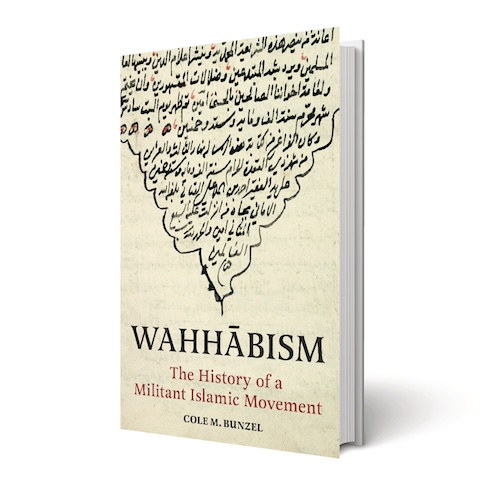When the terrorist army that calls itself “the Islamic state,” or ISIS, captured large parts of Iraq and Syria in the mid-2010s, the world was shocked. Many Muslims around the world were also shocked, because the savagery of this self-declared “caliphate” was deeply at odds with what they knew as their religion. Many of them, therefore, simply declared that ISIS had nothing to do with Islam.
The history of Islam is a complex one and includes a variety of schools and reform movements, a small number of which advocated hatred for and violence against “infidels” and “polytheists.” Understanding the roots of these sects is especially helpful today.

By Cole M. Bunzel
(Princeton University Press, 2023)
Meanwhile, some Islamic scholars offered a more nuanced explanation: ISIS had something to do with Islam, but only as the rebirth of a much-loathed ancient heresy: the Khawarij, or “the Dissenters.” This was an extremely fanatical and violent sect that emerged in the middle of Islam’s first civil war, in the mid-seventh century. Its members condemned all other Muslims as “infidels” and set upon killing them. No wonder these ancient Dissenters have been abhorred by both Sunni and Shiite Muslims alike, going down in history as an extremely militant offshoot of a great religion.
There was one thing, however, that did not fit this Khawarij analogy: the way ISIS sees itself. The Khawarij were clearly a sect outside Sunnism, the largest denomination of Islam, which makes up of almost 90% of all Muslims. ISIS, however, as evident from all its declarations and publications, did not see itself outside Sunni Islam. Quite the contrary: it perceived itself as the standard bearer of true Sunnism while condemning most other Sunnis, and certainly all Shiites, as “apostates” that deserve to be punished.
No wonder a specific movement within Sunni Islam was designated by ISIS members as the pious precedent to which they are “true heirs.” This was the “blessed Najdi mission,” or Wahhabism as it’s widely known, whose history and ideology is scrutinized in a new book by Cole M. Bunzel: Wahhābism: The History of a Militant Islamic Movement.
As Bunzel narrates it, the story began in the 1740s in Najd, the geographic center of the Arabian peninsula—hence the term “Najdi mission—which used to be a landlocked backwater until the discovery of oil in the 20th century. Here, a passionate preacher named Muhammad ibn Abd al-Wahhab (d. 1792) began to spread a new religious awakening: he called all Muslims to strictly abstain from shirk, or “polytheism,” and affirm tawhid, or “monotheism.”
Now that was a bizarre demand, because Islam itself was born more than a millennium before as a campaign against shirk—literally “associating partners” with God—which is the Qur’anic term for the idolatrous religion of pre-Islamic Arabs. This battle was won quickly, during the very life of the Prophet Muhammad (AD c. 570–632), when idolatry was wiped from all Arabia—partly through preaching, partly through conquest. Since then, all Muslims have affirmed the Islamic motto of monotheism, “There is no god but God,” and they certainly have abhorred any manifestation of polytheism.
Condemning a theological error was not enough. It was also necessary to ‘show hatred and enmity’ to it.
But for Ibn Wahhab, this historic victory was just an illusion, because most of the Muslims of his time had fallen back into a new kind of shirk. What he meant primarily was the popular “cult of saints”: Muslims would visit the graves of saints and prophets and pray there to God, hoping for tawassul, or “intercession,” from these great dead men. For most people, this had nothing to do with polytheism. For Ibn Wahhab, however, it was exactly that. So these visitors of graves were no longer Muslims but “grave worshippers.”
That condemnation was just the beginning of Ibn Wahhab’s campaign. Condemning a theological error, let alone merely criticizing it, was not enough. It was also necessary to “show hatred and enmity” to it. Those who failed to demonstrate this zeal failed to be good Muslims, as Ibn Wahhab instructed followers:
Do not think if you say, “This is the truth. I follow it and I abjure all that is against it, but I will not confront them [i.e., the saints being worshipped] and I will say nothing concerning them,” do not think that that will profit you. Rather, it is necessary to hate them, to hate those who love them, to revile them, and to show them enmity.
That enmity was to become the basis for the next step: violent jihad. The much-hated “polytheists,” in other words, had to be physically targeted. That is why, as Bunzel defines it aptly, the teachings of Ibn Wahhab would create a movement of “theological exclusivism combined with militant activism.”
A key step in this direction was the historical alliance that Ibn Wahhab created, around the year 1744, with the local ruler of Diriyah, a small town on the outskirts of today’s Riyadh. That ruler was Muhammad bin Su’ud, who embraced all of Ibn Wahhab’s ideas and committed to championing them, leaving behind a long-lasting alliance between his own family, Al Su’ud, and Ibn Wahhab’s family, Al al-Shaykh.

From this alliance emerged what historians call the First Saudi State (1727–1818), which Bunzel examines in a chapter titled, “The Warpath of Early Wahhabism.” Imagining themselves as the only true Muslims, and other Muslims around them as “polytheists,” the forces of Su’ud first engaged in “defensive jihad,” only to escalate later into “offensive jihad.” Among their targets were al-turk al-kuffar, or “the infidel Turks,” meaning the Ottoman Empire, which was the Islamic superpower of the time that controlled the holy cities of Mecca and Medina, both which would be captured for several years by Wahhabi forces. Their greatest atrocity was the 1802 attack on the Shiite holy city of Karbala, where “they killed most of its people in the markets and homes,” murdering 2,000 innocents at least, or even as many as 4,500 according to another account.
In 1818, this First Saudi State was crushed by Ottoman-allied Egyptian forces. But the Wahhabi mission soon established the Second Saudi State (1824–91), and then the Third Saudi State (1902–32). Only in the latter one, Bunzel shows, did the initial ferocity of the Wahhabi movement finally calm down, largely due to the political pragmatism of the new ruler, Abdulaziz bin Abdul Rahman Al Su’ud, who in 1932 became the first king of modern-day Saudi Arabia. The king needed good relations with other Muslims nations, as well as with “Western oil workers.” So, under his rule, Wahhabi scholars, who also believed in “obeying the ruler” strictly, refrained from condemning other Muslims and condoning violent action. But this pragmatic moderation did not come with much soul-searching about Wahhabism’s initial militancy, which only remained dormant.
This political history of the Wahhabi-Saudi alliance is not new, but Bunzel gives us new details based on primary source materials and weaves them into an interesting story. Even more compelling, perhaps, is how the book maps the place of Wahhabism in the overall Islamic picture. As is well known, there are four established schools of jurisprudence in Sunni Islam: Hanafi, which is often the most rationalist and flexible, followed by Maliki, Shafi’i, and finally Hanbali, which is often the most textualist and rigid. Unlike other Sunnis, for example, Hanbalis have typically rejected kalam, or theology, finding it unnervingly speculative, while they totally shut the door to Greek philosophy, which other Sunnis, as well as Shiites, could at least partly engage with.
So Wahhabism, born in the 18th century, was in fact an offshoot of Hanbalism, which itself was born in the ninth century. But there was a notable stop along the way: the ideas of 13th century Hanbali scholar Ibn Taymiyya (d. 1328), which Bunzel covers in a chapter titled “The Taymiyyan Background.” This background is complicated because Ibn Taymiyya was a sophisticated thinker who introduced nuanced ideas about the congruence of reason and revelation, and rejected prevalent Sunni views about a voluntarist God whose wisdom is beyond comprehension. The troubling part of his legacy was his intolerant verdicts on blasphemy and heresy, and his “severe opposition” to Sufism and the cult of saints. It is this latter part of the Taymiyyan background that the Wahhabis inherited, Bunzel argues, taking them to a much more extreme level.
Imagining themselves as the only true Muslims, the forces of Su’ud first engaged in ‘defensive jihad,’ only to escalate later into ‘offensive jihad.’
Another theme in the book is the rebirth of “militant Wahhabism” in the second part of the 20th century. By the 1930s, as noted above, Wahhabism had lost much of its early fierceness and become a deeply illiberal but politically meek tradition. In the 1960s, however, a new energy poured in from Egypt with the writings of Sayyid Qutb, who spearheaded a militant offshoot of Egypt’s main Islamist movement, the Muslim Brotherhood. Qutb’s most radical idea was similar to that of Ibn Wahhab: most contemporary Muslims were not actually Muslims but “polytheists.” Their “infidelity” was not evidenced by the old problem of the cult of saints, though. Qutb was concerned with something new: secularity. By accepting a life under secular laws and rulers, Qutb believed, most Muslims had begun worshipping “idols” that had “usurped God’s divine prerogatives regarding legislation.” This concept of “legal-political shirk,” as Bunzel calls it, would become the battle cry of a new trend called “Salafi Jihadism,” whose cascade of militancy would ultimately produce al-Qaeda and ISIS.
Telling this complicated story in accessible prose, Wahhābism is a fine book worth reading by anyone interested in the history of ideas in Islam. As a Muslim, I drew two opposite lessons from it. On the one hand, those who use terrorist groups like ISIS to depict a dark picture about all Islam are dead wrong. Terrorists represent only the most extreme version of the most rigid interpretation of Islam.
On the other hand, ISIS and its ilk, as well as their forerunners in the First Saudi State, serve as warnings of a dangerous idea that can contaminate any religion: the definition of piety as self-righteous hatred for the impious, the heretic, the infidel—instead of a righteous compassion for them. It is a poison that can wreak much havoc not just between religions but also within the very religion itself, as the “Najdi mission” painfully demonstrated.













